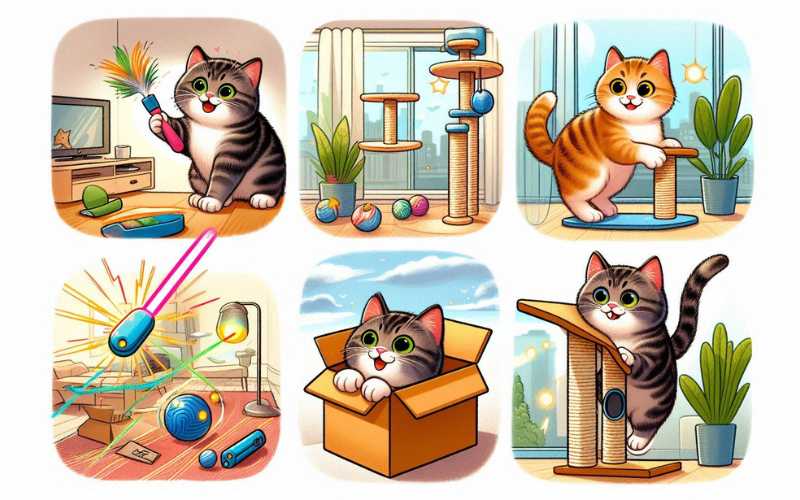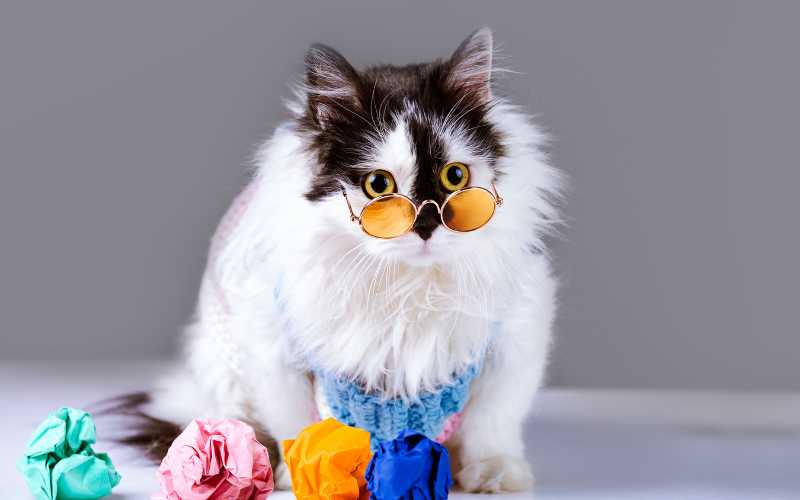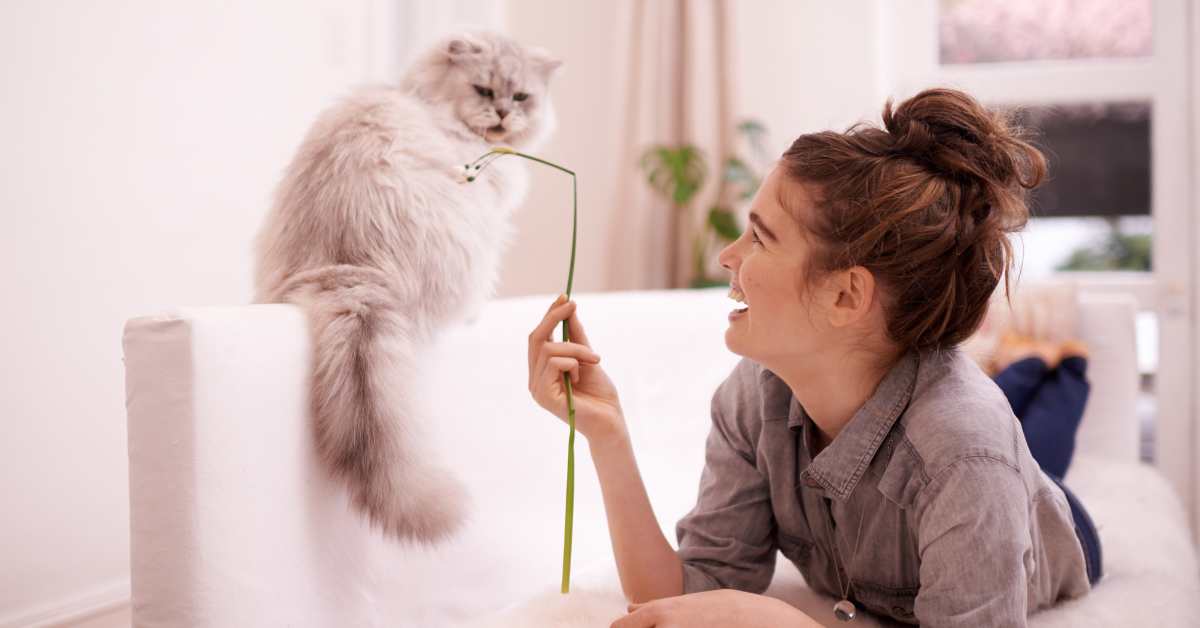Cats are curious creatures, and just like humans, they need entertainment to stay healthy and happy. Whether they’re indoor or outdoor pets, providing fun and engaging activities for your feline friend is essential for their overall well-being. Without proper stimulation, cats can become bored, anxious, or even destructive, leading to unwanted behavior like scratching furniture or overeating. Keeping your cat entertained helps prevent these issues while also nurturing their mental and physical health.
From interactive toys to simple DIY solutions, there are countless ways to keep your cat engaged and entertained. In this article, we’ll explore why cat entertainment is important, different types of entertainment your cat will love, and even some creative, budget-friendly ideas to keep your kitty active and happy.
Why Is Cat Entertainment Important?

Providing entertainment for your cat is more than just about fun—it’s crucial for their health. Cats are natural hunters, and without opportunities to engage their instincts, they can experience boredom and stress. This lack of stimulation can lead to behavior problems such as scratching, excessive meowing, or even overeating. By keeping your cat entertained, you help them stay active and mentally engaged, which improves their overall quality of life.
Engaging your cat in play can also prevent obesity, a common issue for indoor cats. Physical activity helps them burn calories, maintain a healthy weight, and reduce the risk of health problems like diabetes and joint issues. Mentally stimulating activities like puzzle feeders or interactive toys challenge your cat’s brain, preventing cognitive decline as they age. In short, cat entertainment isn’t just a luxury—it’s a vital part of ensuring your pet’s physical and mental well-being.
Types of Cat Entertainment

There are many ways to keep your cat entertained, from interactive play to solo activities. Here are some popular types of cat entertainment that can engage your feline friend:
Interactive Play
Interactive play involves toys that you use to play with your cat directly. These toys are designed to mimic the natural movements of prey, tapping into your cat’s hunting instincts. Examples include feather wands, laser pointers, and fishing rod toys. Playing with your cat helps strengthen your bond while providing them with physical exercise and mental stimulation.
Solo Toys
Solo toys are perfect for times when your cat is alone. These toys allow them to entertain themselves, keeping them busy while you’re at work or running errands. Popular options include balls, stuffed mice, puzzle feeders, and catnip-filled toys. Puzzle feeders, in particular, challenge your cat’s problem-solving skills while rewarding them with treats.
Cat Trees and Scratching Posts
Cats love to climb and scratch—both are natural behaviors that help them stay active and stretch their muscles. A cat tree or scratching post gives your cat a designated spot to climb, scratch, and observe their surroundings. These structures also provide a place for your cat to rest, perch, and feel safe, reducing anxiety and stress.
Technology-Based Entertainment
In today’s tech-savvy world, even cats can enjoy high-tech entertainment! There are apps specifically designed for cats, featuring moving objects or creatures that your cat can “chase” on a tablet or phone screen. Additionally, automated laser toys and robotic mice can keep your cat entertained for hours without much effort on your part. Even YouTube offers a variety of videos designed to captivate cats with sounds and motion.
How to Keep Indoor Cats Entertained

Indoor cats often face limited opportunities for exercise and exploration compared to their outdoor counterparts. However, you can create a stimulating environment that keeps them active and engaged. Here are some effective ways to entertain indoor cats:
Create a Stimulating Environment
Cats are natural explorers, and they love to investigate their surroundings. You can recreate this sense of adventure indoors by providing spaces that encourage climbing, jumping, and hiding. Cat trees, shelves, or window perches can add vertical space, giving your cat more places to roam and perch. These areas provide mental stimulation and give them a vantage point to observe their environment.
Use Rotating Toys
Cats can easily lose interest in toys if they play with the same ones every day. To keep things exciting, rotate your cat’s toys regularly. This doesn’t mean buying new toys constantly—simply store some away for a while and then reintroduce them later. By switching up the toys in their play area, you can keep your cat engaged and curious.
Provide Window Perches
Even though your cat may be indoors, they can still enjoy watching the outside world. Set up a window perch or bed where your cat can sit and observe birds, squirrels, or other outdoor activities. The sights and sounds of nature can be a great source of entertainment for them. You can even add bird feeders outside the window to create a “cat TV” experience.
Interactive Feeding
Turn mealtime into a fun, mentally stimulating activity by using puzzle feeders or slow-feeding bowls. These feeders make your cat work for their food by solving puzzles or navigating obstacles. It not only challenges their mind but also helps prevent overeating by slowing down their eating process. This method is a great way to combine nourishment with play.
DIY Cat Entertainment Ideas

If you’re looking for cost-effective and creative ways to entertain your cat, there are plenty of do-it-yourself (DIY) options that are fun for both you and your pet. Many household items can be repurposed into exciting toys and activities that will keep your cat engaged.
Homemade Toys
You don’t need expensive gadgets to entertain your cat—simple items like cardboard boxes, paper bags, or toilet paper rolls can provide hours of fun. Cats love to hide, pounce, and explore, making boxes perfect for creating a mini fort or maze. Paper bags can also be an exciting toy—just crinkle them up and let your cat dive in! You can even fill old socks with catnip or attach a string to a feather for a homemade toy that mimics prey.
Obstacle Courses
Use your furniture or household items to create a simple obstacle course for your cat. Set up hurdles using pillows or small boxes, or arrange chairs for them to weave through. This not only helps your cat get some exercise but also satisfies their natural urge to jump and explore new areas. The best part is that you can change the course easily, keeping your cat curious and engaged.
Hiding Spots and Tunnels
Cats love to hide and sneak through tunnels. You can create hiding spots around the house using blankets, cushions, or even empty laundry baskets. Tunnels are especially popular with cats and can be easily made from cardboard boxes or by draping blankets between furniture. These hiding places make your cat feel safe and can add an extra layer of excitement during playtime.
Playtime with Household Objects
Sometimes the simplest items make the best toys. A crumpled-up piece of paper, a bottle cap, or a piece of string can provide endless entertainment for your cat. Just be sure to supervise when using string to avoid any accidents. These easy-to-find objects can give your cat a chance to chase, bat, and pounce, helping them stay active and mentally engaged.
Technology and Cat Entertainment
In today’s digital age, technology isn’t just for humans—cats can enjoy tech-based entertainment too! With a variety of apps, videos, and automated gadgets designed specifically for pets, keeping your cat entertained has never been easier. However, it’s essential to balance tech-based play with physical activities to ensure a well-rounded experience for your cat.
Cat Apps and Games
There are numerous apps created for cats that mimic the movements of prey like fish, birds, or insects on a screen. These apps allow your cat to “hunt” by tapping at the moving objects, providing mental stimulation and a safe outlet for their hunting instincts. All you need is a tablet or smartphone, and your cat can have fun chasing digital creatures without much effort on your part.
YouTube Videos for Cats
YouTube offers a treasure trove of videos made specifically to entertain cats. These videos often feature birds chirping, squirrels running, or fish swimming, and the sights and sounds can keep your cat engaged for long periods. Simply set up a screen where your cat can watch and let them enjoy their own version of “cat TV.” This visual stimulation can be especially effective for indoor cats who don’t get to experience the outdoors regularly.
Automated Toys and Gadgets
Robotic toys and automated gadgets can provide hours of entertainment without constant supervision. Automated laser pointers, robotic mice, and motion-activated toys can engage your cat’s hunting instincts, keeping them on their toes. These devices are particularly useful when you’re busy but want to make sure your cat stays active. Some automated toys even allow you to schedule playtime remotely, ensuring your cat has something fun to do while you’re away.
Balancing Technology with Physical Play
While technology-based entertainment is convenient, it shouldn’t replace physical play and interaction. It’s essential to strike a balance between tech-based activities and more traditional play to keep your cat physically active and mentally stimulated. Combining both ensures your cat gets the best of both worlds, helping them stay healthy, happy, and entertained.
The Role of Cat Companions in Entertainment
While toys and activities are great ways to entertain your cat, sometimes the best entertainment comes from companionship. Having another cat or pet in the house can provide endless hours of social interaction, play, and bonding. Cats are social animals, and many of them thrive in environments where they have a buddy to share their time with.
Benefits of Having More Than One Cat
Introducing a second cat into your home can greatly enhance your pet’s entertainment and overall well-being. Cats that get along will often engage in playful activities together, such as chasing, wrestling, and grooming each other. This natural social interaction keeps both cats mentally and physically active, reducing boredom and anxiety. It can also ease loneliness, especially when you’re not home, providing them with a constant playmate.
Introducing New Pets for Socialization
If you’re considering adding a new pet, it’s important to introduce them gradually. Cats are territorial by nature, and sudden changes can be stressful. Start by keeping the new pet in a separate room and letting your cats sniff each other under the door. Gradually increase their interactions under supervision until they are comfortable together. With time, your cat may enjoy the company of another cat, or even a dog, and they’ll have a built-in playmate to keep them entertained.
Playful Social Interaction
Cats that live with companions often engage in social play, which includes chasing each other, play-fighting, and even sharing toys. This type of interaction provides not only physical exercise but also mental stimulation, as cats learn social cues and boundaries. Having another animal around ensures your cat is consistently entertained, even when you’re not available for playtime.
While not all cats will welcome a new companion, many benefit from having another animal to interact with, and this socialization helps enrich their daily life.
Balancing Rest and Playtime
While keeping your cat entertained is important, it’s equally essential to ensure they get enough rest. Cats are known for sleeping a lot—up to 16 hours a day! Finding the right balance between play and rest is key to maintaining your cat’s overall health and happiness.
Understanding Cat Sleep Patterns
Cats are crepuscular animals, which means they are most active during dawn and dusk. Their natural instincts drive them to rest during the day and night, reserving their energy for hunting (or playing) during the early morning and evening hours. It’s important to recognize your cat’s natural rhythm and schedule playtime when they are most active, typically in the morning or late afternoon.
Creating a Comfortable Resting Environment
Providing your cat with cozy resting spots throughout your home encourages them to take adequate breaks between play sessions. Cat beds, window perches, or even soft blankets in a quiet corner can give them a comfortable place to relax. Having a variety of nap spots allows your cat to choose a location that makes them feel safe and secure.
Structured Play Sessions
To help balance rest and playtime, try to establish regular play sessions with your cat. By having a routine, your cat knows when to expect active play and when it’s time to rest. This structured approach keeps your cat mentally stimulated, while also giving them a clear schedule for winding down. Short bursts of play, about 10-15 minutes at a time, are often enough to satisfy their hunting instincts and burn off excess energy.
Avoid Overstimulation
While it’s fun to keep your cat entertained, overdoing it can lead to overstimulation. Signs of overstimulation include sudden biting or scratching during play or if your cat becomes overly agitated. If this happens, it’s a good indication to let them rest. Always ensure your cat has enough downtime to relax and recharge between activities. A well-rested cat will be more eager and engaged during their next play session, leading to a happier and healthier pet.
The Importance of Mental Stimulation
In addition to physical play, mental stimulation is a critical component of cat entertainment. Cats are highly intelligent creatures, and without enough challenges to keep their minds engaged, they can become bored, anxious, or even destructive. Mental stimulation helps prevent boredom-related behaviors and improves your cat’s overall quality of life.
Puzzle Feeders and Food-Dispensing Toys
One of the easiest ways to provide mental stimulation for your cat is by using puzzle feeders or food-dispensing toys. These devices require your cat to solve simple puzzles or figure out how to manipulate the toy to release treats or kibble. This type of activity engages their brain, encouraging problem-solving skills while also satisfying their natural hunting instincts.
Training and Trick Learning
Cats can be trained just like dogs! Teaching your cat basic commands or tricks, such as “sit,” “high five,” or even how to use a scratching post, can be a rewarding way to provide mental stimulation. Using positive reinforcement techniques like treats or affection helps your cat associate learning with positive experiences. Training sessions are short but effective at keeping your cat engaged and mentally sharp.
Interactive Games and Challenges
Interactive games such as hide-and-seek or treasure hunts can be great for mental stimulation. Hide treats or toys in various spots around the house and let your cat find them. This taps into their natural curiosity and sense of adventure. You can also try moving furniture or creating new spaces for your cat to explore. Changing their environment, even in small ways, can keep things fresh and exciting.
Rotating Activities and Toys
Just like humans, cats get bored with the same routine. To keep your cat mentally stimulated, rotate toys, games, and activities regularly. Introducing new challenges, such as different types of puzzle feeders or new interactive toys, keeps your cat engaged and interested in their surroundings. A variety of experiences ensures that your cat stays curious and mentally active.
Providing your cat with plenty of mental stimulation will help them stay alert, engaged, and happy. By incorporating challenging activities into their routine, you not only enrich their life but also reduce the chances of boredom-induced behaviors.
Signs Your Cat Needs More Entertainment
Recognizing when your cat is feeling bored or under-stimulated is crucial for their well-being. Cats communicate their needs and emotions through behavior, and being attentive to these signs can help you determine when it’s time to step up their entertainment. Here are some common indicators that your feline friend may need more engagement in their daily routine.
Destructive Behavior
One of the most obvious signs that your cat is bored is destructive behavior. If your cat is scratching furniture, knocking things over, or chewing on household items, it could be a cry for more stimulation. Cats need an outlet for their energy, and without adequate entertainment, they may turn to inappropriate behaviors. Providing more playtime, interactive toys, or even scratching posts can redirect their energy positively.
Excessive Vocalization
If your cat is meowing or yowling more than usual, it might be a sign that they are bored or seeking attention. While some cats are naturally more vocal than others, excessive vocalization can indicate that they are looking for stimulation. Pay attention to their vocal cues and consider engaging them in play or providing new toys to keep their minds occupied.
Lethargy and Disinterest
A cat that seems lethargic or disinterested in their surroundings might be feeling bored. If your cat is sleeping more than usual, has lost interest in play, or seems less active than before, it could indicate a lack of stimulation. Incorporating more playtime and interactive activities can help revive their energy and interest in their environment.
Pacing or Restlessness
Cats may display pacing or restlessness when they feel under-stimulated. If you notice your cat wandering aimlessly, looking for something to do, or displaying signs of anxiety, it’s a good indication they need more entertainment. This behavior can also stem from pent-up energy, which can be addressed by providing regular play sessions and interactive toys.
Seeking Out Human Interaction
Cats often seek their human companions for entertainment when they’re feeling bored. If your cat is following you around, pawing at you, or trying to engage you in play, it could be a sign that they want more interaction. Make time to play with your cat or invest in toys that allow for cooperative play, ensuring they feel engaged and stimulated.
By being mindful of these signs, you can proactively enhance your cat’s environment and activities, ensuring they remain happy, healthy, and entertained. Regularly evaluating their needs and adjusting their entertainment routine will lead to a more fulfilling life for your feline friend.


